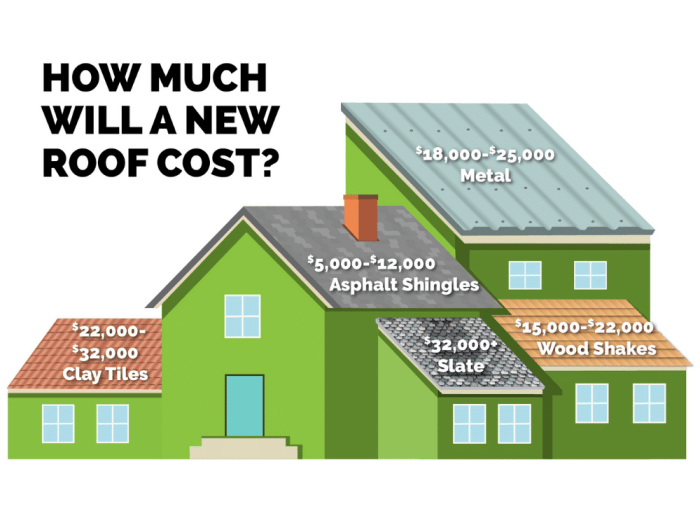Exploring the anticipated costs of roof replacement in 2025 opens up a world of possibilities and considerations. From the evolving trends in roofing materials to the impact of labor costs and sustainability, this topic delves into the intricacies of future expenses and choices.
Join us on this journey as we unravel the factors shaping the roof replacement landscape in the upcoming years.
Factors Affecting Roof Replacement Costs
When it comes to the cost of roof replacement, several factors can significantly impact the overall pricing. Understanding these factors can help homeowners make informed decisions when planning for a roof replacement project.
Material Choices
The type of roofing material selected for the replacement can have a significant impact on the overall cost. Different materials come with varying price points, durability, and aesthetic appeal. For example, asphalt shingles are a popular and cost-effective option, while metal roofs are more expensive but offer longevity and energy efficiency.
Labor Costs
Labor costs play a crucial role in determining the overall cost of roof replacement. The complexity of the project, the experience of the roofing contractor, and the location of the property can all influence labor costs. For instance, a steep roof with multiple angles and levels may require more labor and time, resulting in higher costs.
Roof Size and Pitch
The size and pitch of the roof are key factors that can impact the cost of replacement. A larger roof will require more materials and labor, leading to higher expenses. Additionally, a steeply pitched roof can be more challenging to work on, increasing the labor costs.
Underlying Damage
The presence of underlying damage, such as rot or water leaks, can also affect the cost of roof replacement. If the existing roof structure is compromised, it may need repairs or reinforcement before the new roof can be installed. Addressing underlying damage can add to the overall project cost.
Location
The location of the property can influence the cost of roof replacement due to factors like local building codes, permits, and access to materials. Urban areas with higher living costs may have higher labor rates, while rural areas may have limited access to certain roofing materials, affecting pricing.
Trends in Roofing Materials and Their Costs
Roofing materials have evolved significantly over the years, with new options constantly entering the market. These trends in roofing materials directly impact the costs associated with roof replacement projects.
Comparison of Traditional and Modern Roofing Materials
- Asphalt Shingles: Asphalt shingles have been a popular choice for many years due to their affordability and ease of installation. However, they may not last as long as some newer options.
- Metal Roofing: Metal roofing has gained popularity for its durability and longevity. While the initial cost may be higher than asphalt shingles, metal roofs can last much longer, potentially offering cost savings in the long run.
- Solar Panels: With a focus on sustainability, solar panels integrated into roofing materials are becoming more common. While the upfront cost is high, the potential energy savings and environmental benefits make them an attractive option for many homeowners.
Impact of Technological Advancements on Material Costs
Advancements in technology have led to the development of more efficient and durable roofing materials. These innovations can impact material costs in various ways, such as:
- Improved durability: Materials that are more resistant to weather elements and wear and tear may have a higher upfront cost but can save money on repairs and replacements in the long term.
- Energy efficiency: Energy-efficient materials can help reduce heating and cooling costs, making them a cost-effective choice in the long run.
- Smart technology integration: Roofing materials that incorporate smart technology for monitoring and maintenance can offer convenience and potentially reduce long-term costs by detecting issues early.
Labor Costs and Market Trends

Labor costs play a significant role in determining the overall expenses of roof replacement projects. Understanding the current labor market trends in the roofing industry is crucial to anticipate how these costs may fluctuate.
Analysis of Current Labor Market Trends
- Roofing industry experiencing a shortage of skilled labor due to an aging workforce and lack of new entrants.
- Increased demand for roof replacement projects leading to higher competition for skilled workers.
- Technological advancements in roofing methods requiring specialized training, impacting labor availability.
Variability of Labor Costs Based on Location and Demand
- Urban areas with high demand for roof replacements tend to have higher labor costs compared to rural areas.
- Regions prone to extreme weather conditions may experience spikes in labor costs during peak seasons.
- Overall economic conditions and cost of living in a particular area can influence local labor rates.
Impact of Labor Shortages or Surpluses on Roof Replacement Costs
- Shortages of skilled labor can drive up labor costs as contractors compete for a limited workforce.
- Labor surpluses in certain regions may lead to lower labor rates but could indicate quality concerns.
- Unstable labor market conditions can create uncertainties in project timelines and overall costs.
Environmental Impact and Sustainability Costs
In recent years, there has been a growing emphasis on the importance of environmentally friendly practices in various industries, including roofing. The construction sector, in particular, has seen a shift towards sustainable materials and methods to reduce carbon footprint and promote long-term environmental health.Sustainable roofing options, such as solar panels, green roofs, and recycled materials, have gained popularity due to their ability to lower energy consumption, reduce waste, and minimize the impact on the environment.
While these eco-friendly solutions may have a higher upfront cost compared to traditional roofing materials, the long-term benefits often outweigh the initial investment.
Impact of Sustainable Materials on Roof Replacement Costs
- Using sustainable materials like metal roofs or cool roofs can increase the initial cost of roof replacement due to higher material prices and specialized installation requirements.
- However, the durability and energy efficiency of these materials can lead to lower maintenance costs and reduced energy bills over time, making them a cost-effective choice in the long run.
- Additionally, some sustainable roofing options, such as solar panels, may qualify for tax incentives or rebates, further offsetting the initial cost.
Long-Term Cost Benefits of Eco-Friendly Roofing Solutions
- Eco-friendly roofing solutions are designed to last longer and require less maintenance compared to traditional materials, leading to reduced repair and replacement expenses in the future.
- By incorporating sustainable practices into roof replacement projects, homeowners and businesses can contribute to a healthier environment and lower their overall carbon footprint.
- Moreover, the energy savings achieved through sustainable roofing options can result in significant cost savings on heating and cooling bills, providing a tangible financial benefit in the long term.
Concluding Remarks
As we conclude our discussion on The Real Cost of Roof Replacement in 2025, one thing is clear: the future of roofing expenses is dynamic and multifaceted. By understanding the various influences on costs, from materials to labor and sustainability, individuals can make informed decisions when it comes to roof replacements.
Stay informed, stay proactive, and pave the way for a cost-effective and sustainable roofing future.
Frequently Asked Questions
How do advancements in technology impact material costs?
Technological advancements often lead to the development of more efficient and cost-effective roofing materials, which can influence the overall cost of roof replacement in 2025.
What are some examples of sustainable roofing options that may affect costs?
Examples of sustainable roofing options include solar panels, green roofs, and recycled materials, which may have varying costs compared to traditional materials.
How can location affect labor costs in the roofing industry?
Location plays a significant role in determining labor costs, with areas experiencing high demand for roofing services likely to have higher labor expenses.
Are eco-friendly roofing solutions more cost-effective in the long run?
Yes, eco-friendly roofing solutions may have higher initial costs but can lead to long-term savings through improved energy efficiency and reduced maintenance expenses.














